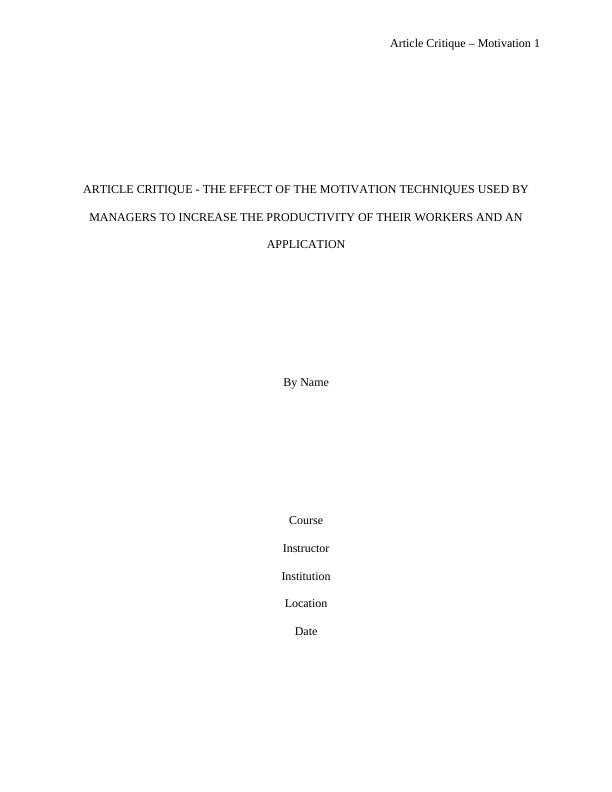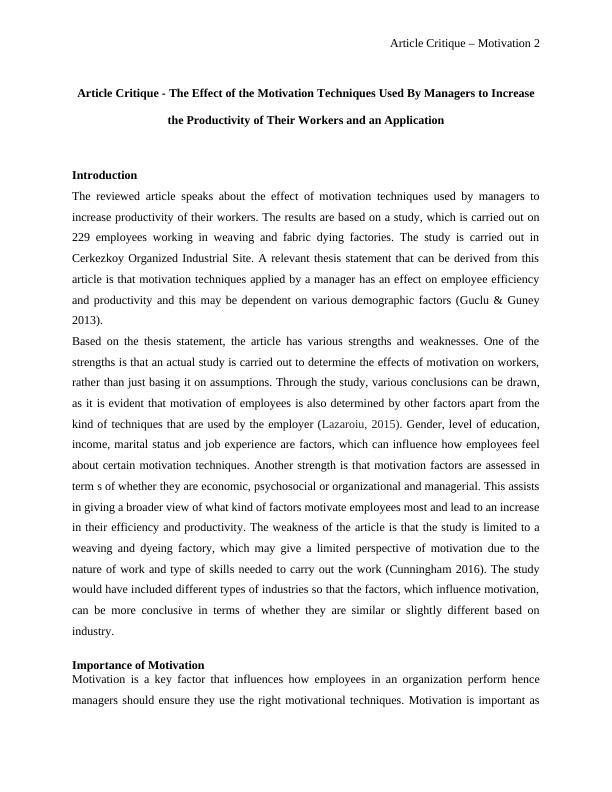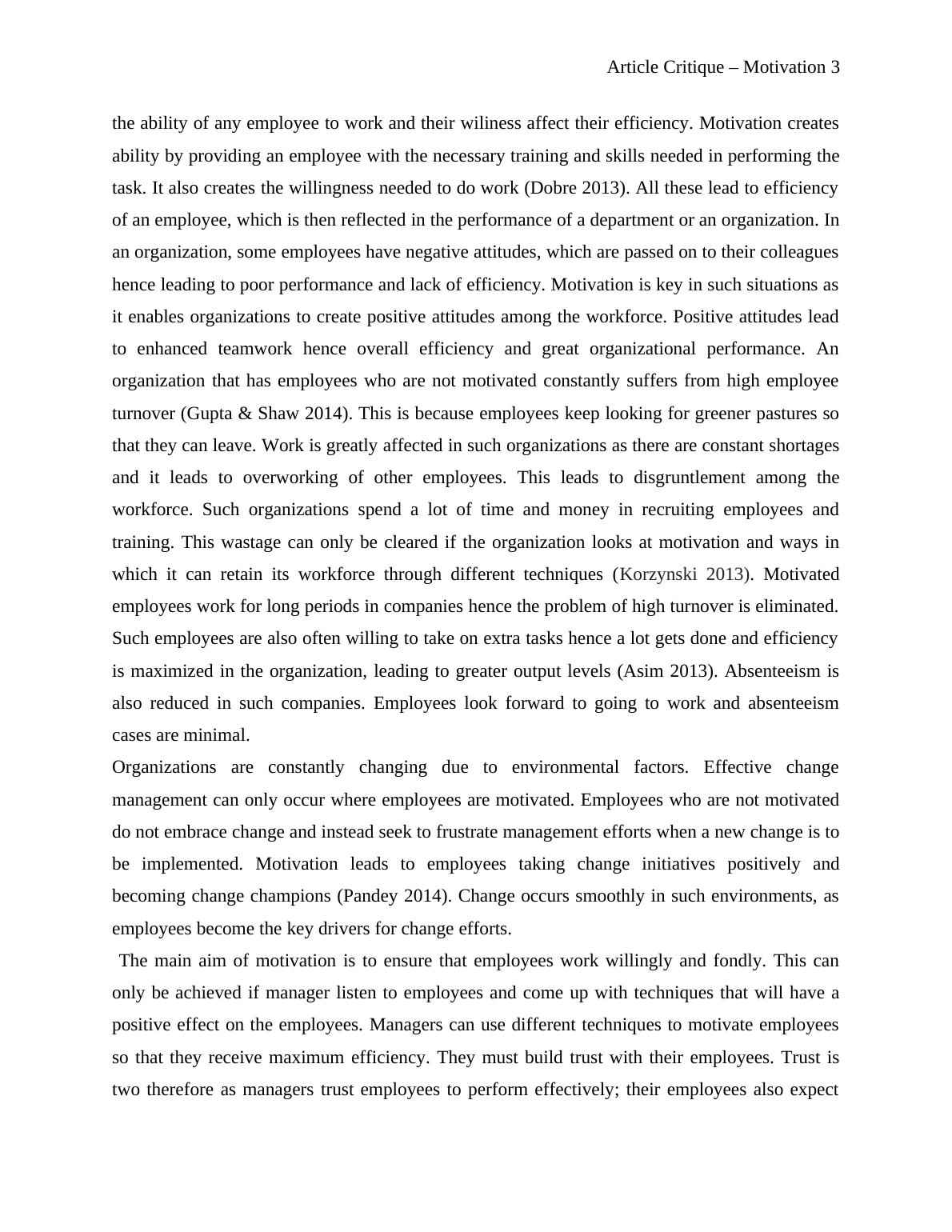The Effect of the Motivation Techniques Article
Added on 2020-04-07
7 Pages2085 Words51 Views
Article Critique – Motivation 1
ARTICLE CRITIQUE - THE EFFECT OF THE MOTIVATION TECHNIQUES USED BY
MANAGERS TO INCREASE THE PRODUCTIVITY OF THEIR WORKERS AND AN
APPLICATION
By Name
Course
Instructor
Institution
Location
Date
ARTICLE CRITIQUE - THE EFFECT OF THE MOTIVATION TECHNIQUES USED BY
MANAGERS TO INCREASE THE PRODUCTIVITY OF THEIR WORKERS AND AN
APPLICATION
By Name
Course
Instructor
Institution
Location
Date

Article Critique – Motivation 2
Article Critique - The Effect of the Motivation Techniques Used By Managers to Increase
the Productivity of Their Workers and an Application
Introduction
The reviewed article speaks about the effect of motivation techniques used by managers to
increase productivity of their workers. The results are based on a study, which is carried out on
229 employees working in weaving and fabric dying factories. The study is carried out in
Cerkezkoy Organized Industrial Site. A relevant thesis statement that can be derived from this
article is that motivation techniques applied by a manager has an effect on employee efficiency
and productivity and this may be dependent on various demographic factors (Guclu & Guney
2013).
Based on the thesis statement, the article has various strengths and weaknesses. One of the
strengths is that an actual study is carried out to determine the effects of motivation on workers,
rather than just basing it on assumptions. Through the study, various conclusions can be drawn,
as it is evident that motivation of employees is also determined by other factors apart from the
kind of techniques that are used by the employer (Lazaroiu, 2015). Gender, level of education,
income, marital status and job experience are factors, which can influence how employees feel
about certain motivation techniques. Another strength is that motivation factors are assessed in
term s of whether they are economic, psychosocial or organizational and managerial. This assists
in giving a broader view of what kind of factors motivate employees most and lead to an increase
in their efficiency and productivity. The weakness of the article is that the study is limited to a
weaving and dyeing factory, which may give a limited perspective of motivation due to the
nature of work and type of skills needed to carry out the work (Cunningham 2016). The study
would have included different types of industries so that the factors, which influence motivation,
can be more conclusive in terms of whether they are similar or slightly different based on
industry.
Importance of Motivation
Motivation is a key factor that influences how employees in an organization perform hence
managers should ensure they use the right motivational techniques. Motivation is important as
Article Critique - The Effect of the Motivation Techniques Used By Managers to Increase
the Productivity of Their Workers and an Application
Introduction
The reviewed article speaks about the effect of motivation techniques used by managers to
increase productivity of their workers. The results are based on a study, which is carried out on
229 employees working in weaving and fabric dying factories. The study is carried out in
Cerkezkoy Organized Industrial Site. A relevant thesis statement that can be derived from this
article is that motivation techniques applied by a manager has an effect on employee efficiency
and productivity and this may be dependent on various demographic factors (Guclu & Guney
2013).
Based on the thesis statement, the article has various strengths and weaknesses. One of the
strengths is that an actual study is carried out to determine the effects of motivation on workers,
rather than just basing it on assumptions. Through the study, various conclusions can be drawn,
as it is evident that motivation of employees is also determined by other factors apart from the
kind of techniques that are used by the employer (Lazaroiu, 2015). Gender, level of education,
income, marital status and job experience are factors, which can influence how employees feel
about certain motivation techniques. Another strength is that motivation factors are assessed in
term s of whether they are economic, psychosocial or organizational and managerial. This assists
in giving a broader view of what kind of factors motivate employees most and lead to an increase
in their efficiency and productivity. The weakness of the article is that the study is limited to a
weaving and dyeing factory, which may give a limited perspective of motivation due to the
nature of work and type of skills needed to carry out the work (Cunningham 2016). The study
would have included different types of industries so that the factors, which influence motivation,
can be more conclusive in terms of whether they are similar or slightly different based on
industry.
Importance of Motivation
Motivation is a key factor that influences how employees in an organization perform hence
managers should ensure they use the right motivational techniques. Motivation is important as

Article Critique – Motivation 3
the ability of any employee to work and their wiliness affect their efficiency. Motivation creates
ability by providing an employee with the necessary training and skills needed in performing the
task. It also creates the willingness needed to do work (Dobre 2013). All these lead to efficiency
of an employee, which is then reflected in the performance of a department or an organization. In
an organization, some employees have negative attitudes, which are passed on to their colleagues
hence leading to poor performance and lack of efficiency. Motivation is key in such situations as
it enables organizations to create positive attitudes among the workforce. Positive attitudes lead
to enhanced teamwork hence overall efficiency and great organizational performance. An
organization that has employees who are not motivated constantly suffers from high employee
turnover (Gupta & Shaw 2014). This is because employees keep looking for greener pastures so
that they can leave. Work is greatly affected in such organizations as there are constant shortages
and it leads to overworking of other employees. This leads to disgruntlement among the
workforce. Such organizations spend a lot of time and money in recruiting employees and
training. This wastage can only be cleared if the organization looks at motivation and ways in
which it can retain its workforce through different techniques (Korzynski 2013). Motivated
employees work for long periods in companies hence the problem of high turnover is eliminated.
Such employees are also often willing to take on extra tasks hence a lot gets done and efficiency
is maximized in the organization, leading to greater output levels (Asim 2013). Absenteeism is
also reduced in such companies. Employees look forward to going to work and absenteeism
cases are minimal.
Organizations are constantly changing due to environmental factors. Effective change
management can only occur where employees are motivated. Employees who are not motivated
do not embrace change and instead seek to frustrate management efforts when a new change is to
be implemented. Motivation leads to employees taking change initiatives positively and
becoming change champions (Pandey 2014). Change occurs smoothly in such environments, as
employees become the key drivers for change efforts.
The main aim of motivation is to ensure that employees work willingly and fondly. This can
only be achieved if manager listen to employees and come up with techniques that will have a
positive effect on the employees. Managers can use different techniques to motivate employees
so that they receive maximum efficiency. They must build trust with their employees. Trust is
two therefore as managers trust employees to perform effectively; their employees also expect
the ability of any employee to work and their wiliness affect their efficiency. Motivation creates
ability by providing an employee with the necessary training and skills needed in performing the
task. It also creates the willingness needed to do work (Dobre 2013). All these lead to efficiency
of an employee, which is then reflected in the performance of a department or an organization. In
an organization, some employees have negative attitudes, which are passed on to their colleagues
hence leading to poor performance and lack of efficiency. Motivation is key in such situations as
it enables organizations to create positive attitudes among the workforce. Positive attitudes lead
to enhanced teamwork hence overall efficiency and great organizational performance. An
organization that has employees who are not motivated constantly suffers from high employee
turnover (Gupta & Shaw 2014). This is because employees keep looking for greener pastures so
that they can leave. Work is greatly affected in such organizations as there are constant shortages
and it leads to overworking of other employees. This leads to disgruntlement among the
workforce. Such organizations spend a lot of time and money in recruiting employees and
training. This wastage can only be cleared if the organization looks at motivation and ways in
which it can retain its workforce through different techniques (Korzynski 2013). Motivated
employees work for long periods in companies hence the problem of high turnover is eliminated.
Such employees are also often willing to take on extra tasks hence a lot gets done and efficiency
is maximized in the organization, leading to greater output levels (Asim 2013). Absenteeism is
also reduced in such companies. Employees look forward to going to work and absenteeism
cases are minimal.
Organizations are constantly changing due to environmental factors. Effective change
management can only occur where employees are motivated. Employees who are not motivated
do not embrace change and instead seek to frustrate management efforts when a new change is to
be implemented. Motivation leads to employees taking change initiatives positively and
becoming change champions (Pandey 2014). Change occurs smoothly in such environments, as
employees become the key drivers for change efforts.
The main aim of motivation is to ensure that employees work willingly and fondly. This can
only be achieved if manager listen to employees and come up with techniques that will have a
positive effect on the employees. Managers can use different techniques to motivate employees
so that they receive maximum efficiency. They must build trust with their employees. Trust is
two therefore as managers trust employees to perform effectively; their employees also expect

End of preview
Want to access all the pages? Upload your documents or become a member.
Related Documents
MGMT20001 | Organizational Behaviour- Motivational Techniqueslg...
|19
|2184
|40
Organisational Behavior: Articlelg...
|6
|1895
|419
Article on Organizational Behaviorlg...
|7
|2054
|119
Business Management Dynamicslg...
|7
|1881
|36
Essay on The Effect of the Motivation Techniqueslg...
|7
|2100
|158
Article Critique Organizational Behaviorlg...
|6
|1400
|373
